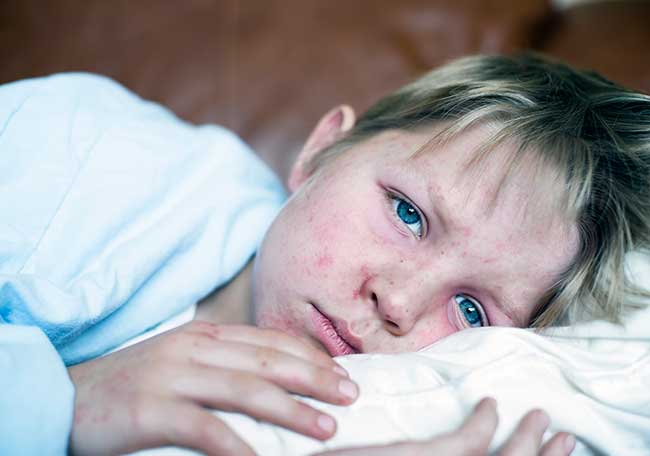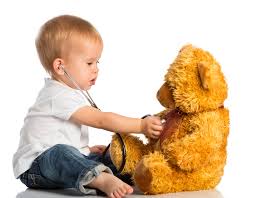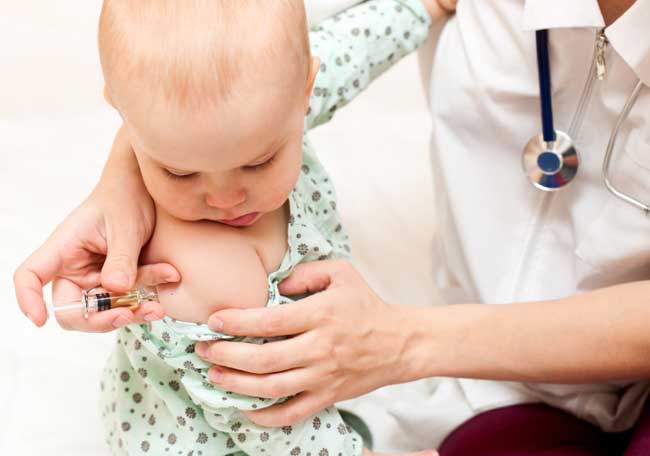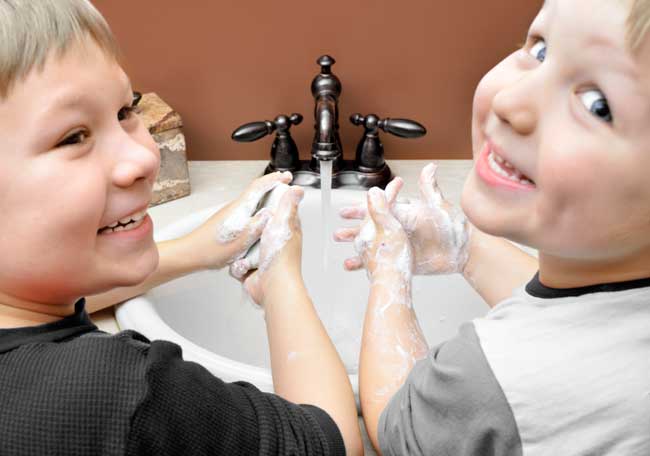Prevención y control de infecciones en pediatría ambulatoria

1. Siegel JD, Rhinehart E, Jackson M, Chiarello L; Healthcare Infection Control Practices Advisory Committee. 2007 guideline for isolation precautions: preventing transmission of infectious agents in healthcare settings. Available at: https:// www. cdc. gov/ infectioncontrol/ pdf/ guidelines/isolation- guidelines.pdf. Accessed March 6, 2017
2. Sehulster L, Chinn RY; CDC; HICPAC. Guidelines for environmental infection control in health-care facilities. Recommendations of CDC and the Healthcare Infection Control Practices Advisory Committee (HICPAC). MMWR Recomm Rep. 2003;52(RR-10):1–42
3. Boyce JM, Pittet D; Healthcare Infection Control Practices Advisory Committee; HICPAC/SHEA/APIC/IDSA Hand Hygiene Task Force; Society for Healthcare Epidemiology of America/Association for Professionals in Infection Control/ Infectious Diseases Society of America. Guideline for Hand Hygiene in Health-Care Settings. Recommendations of the Healthcare Infection Control Practices Advisory Committee and the HICPAC/SHEA/APIC/IDSA Hand Hygiene Task Force. MMWR Recomm Rep. 2002;51(RR-16):1–45, quiz CE1–CE4
4. World Health Organization. Guidelines on hand hygiene in health care. 2009. Available at: http:// apps. who.int/ iris/ bitstream/ 10665/ 44102/ 1/9789241597906_ eng. pdf. Accessed March 6, 2017
5. O’Grady NP, Alexander M, Burns LA, et al; Healthcare Infection Control Practices Advisory Committee (HICPAC). Guidelines for the prevention of intravascular catheterrelated infections. Clin Infect Dis. 2011;52(9):e162–e193
6. Nihill DM, Lundstrom T. Infection prevention and control in the outpatient setting. In: Lautenbach E, Woeltje KF, Malani PN, eds. Practical Healthcare Epidemiology. 3rd ed. Chicago, IL: Society for Healthcare 18 FROM Epidemiology of America, by
the University of Chicago Press; 2010:356–371
7. Jackson MM. Ambulatory care facilities. In: Abrutyn E, Goldmann DA, Scheckler WE, eds. Saunders Infection Control Reference Service. 2nd ed. Philadelphia, PA: WB Saunders Co; 2001:139–150
8. Lobovits AM, Freeman J, Goldmann DA, McIntosh K. Risk of illness after exposure to a pediatric office. N Engl J Med. 1985;313(7):425–428
9. Bloch AB, Orenstein WA, Ewing WM, et al. Measles outbreak in a pediatric practice: airborne transmission in an office setting. Pediatrics. 1985;75(4):676–683
10. Davis RM, Orenstein WA, Frank JA Jr, et al. Transmission of measles in medical settings. 1980 through 1984. JAMA. 1986;255(10):1295–1298
11. Askew GL, Finelli L, Hutton M, et al. Mycobacterium tuberculosis
transmission from a pediatrician to patients. Pediatrics. 1997;100(1): 19–23
12. Moore M, Schulte J, Valway SE, et al. Evaluation of transmission of Mycobacterium tuberculosis
in a pediatric setting. J Pediatr. 1998;133(1):108–112
13. Williams IT, Perz JF, Bell BP. Viral hepatitis transmission in ambulatory health care settings. Clin Infect Dis. 2004;38(11):1592–1598
14. Branch-Elliman W, Weiss D, Balter S, Bornschlegel K, Phillips M. Hepatitis C transmission due to contamination of multidose medication vials: summary of an outbreak and a call to action. Am J Infect Control. 2013;41(1):92–94
15. Samandari T, Malakmadze N, Balter S, et al. A large outbreak of hepatitis B virus infections associated with frequent injections at a physician’soffice. Infect Control Hosp Epidemiol. 2005;26(9):745–750
16. Goodman RA, Solomon SL. Transmission of infectious diseases in outpatient health care settings. JAMA. 1991;265(18):2377–2381
17. American Academy of Pediatrics Committee on Infectious Diseases. Infection prevention and control in pediatric ambulatory settings. Pediatrics. 2007;120(3):650–665
18. Centers for Disease Control and Prevention. Recommendations for preventing transmission of infections among chronic hemodialysis patients. MMWR Recomm Rep. 2001;50(RR-5):1–43
19. Centers for Disease Control and Prevention. Basic infection control and prevention plan for outpatient
oncology settings. 2011. Available at: www. cdc. gov/ hai/ pdfs/ guidelines/ basic- infection- control- prevention- plan- 2011. pdf. Accessed March 6, 2017
20. American Society for Gastrointestinal Endoscopy. Multisociety guideline on reprocessing flexible gastrointestinal endoscopes: 2016 update. Available at: www. asge. org/ uploadedFiles/ Publications_ and_ Products/ Practice_ Guidelines/ Multisociety%20 guideline%20 on%20 reprocessing%20
flexible%20 gastrointestinal. pdf. Accessed March 6, 2017
21. Centers for Disease Control and Prevention. Infection control assessment of ambulatory surgical centers. Available at: www. cdc. gov/ injectionsafety/ pubs- IC- Assessment- Ambulatory- Surgical- Centers. html. Accessed March 6, 2017
22. APIC. APIC implementation guide: guide to infection prevention in emergency medical services. 2013. Available at: http:// apic. org/ Resource_/ EliminationGuideF orm/ e1ac231d- 9d35- 4c42- 9ca0- 822c23437e18/ File/ EMS_ Guide_ web. pdf. Accessed March 6, 2017
23. Liang SY, Theodoro DL, Schuur JD, Marschall J. Infection prevention in the emergency department. Ann Emerg Med. 2014;64(3):299–313
24. Ostrowsky B. Epidemiology of healthcare associated infections. In: Jarvis WR, ed. Bennett and Brachman’s Hospital Infections. 6th ed. Philadelphia, PA: Lippincott Williams and Wilkins; 2007:1–20
25. Rogers M, Weinstock DM, Eagan J, Kiehn T, Armstrong D, Sepkowitz KA. Rotavirus outbreak on a pediatric oncology floor: possible association with toys. Am J Infect Control. 2000;28(5):378–380
26. Avila-Aguero ML, German G, Paris MM,Herrera JF; Safe Toys Study Group. Toys in a pediatric hospital: are they a bacterial source? Am J Infect Control. 2004;32(5):287–290
27. Akhter J, al-Hajjar S, Myint S, Qadri SM. Viral contamination of environmental surfaces on a general paediatric ward and playroom in a major referral centre in Riyadh. Eur J Epidemiol. 1995;11(5):587–590
28. Centers for Disease Control and Prevention. Nail hygiene. Available at: https:// www. cdc. gov/ healthywater/ hygiene/ hand/ nail_ hygiene. html. Accessed March 6, 2017
29. Olsen RJ, Lynch P, Coyle MB, Cummings J, Bokete T, Stamm WE. Examination gloves as barriers to hand contamination in clinical practice. JAMA. 1993;270(3):350–353
30. Quade D. Cough Etiquette. YouTube. 2009. Available at: https:// www.
youtube. com/ watch? v= UNEp5U_ TCOM. Accessed March 6, 2017
31. Ellingson K, Haas JP, Aiello AE, et al; Society for Healthcare Epidemiology of America (SHEA). Strategies to prevent healthcare-associated infections through hand hygiene. Infect Control Hosp Epidemiol. 2014;35(8): 937–960
32. Sprunt K, Redman W, Leidy G. Antibacterial effectiveness of routine hand washing. Pediatrics. 1973;52(2):264–271
33. Lowbury EJ, Lilly HA, Bull JP. Disinfection of hands: removal of transient organisms. Br Med J.
1964;2(5403):230–233
34. Blaney DD, Daly ER, Kirkland KB, Tongren JE, Kelso PT, Talbot EA. Use
of alcohol-based hand sanitizers as a risk factor for norovirus outbreaks in long-term care facilities in northern New England: December 2006 to March 2007. Am J Infect Control. 2011;39(4):296–301
35. Centers for Disease Control and Prevention. Wash your hands (:30). Available at: www. cdc. gov/ cdctv/ healthyliving/ hygiene/ hands- togetherhygiene. html. Accessed March 6, 2017
36. Infection Control Today. FDA issues proposed rule to determine safety and effectiveness of antibacterial soaps. Available at: https:// www.infectioncontrolt oday. com/ news/2013/ 12/ fda- issues- proposed- rule- todetermine-safety- and- effectivenessof-antibacterial- soaps. aspx. Accessed
March 6, 2017
37. Aiello AE, Larson EL, Levy SB. Consumer antibacterial soaps: effective or justrisky? Clin Infect Dis. 2007;45(suppl2):S137–S147
38. American Academy of Pediatrics. Infection control and prevention in hospitalized children. In: Kimberlin DW, Brady MT, Jackson MA, Long SS, eds. Red Book: 2015 Report of the Committee on Infectious Diseases. 30th ed. Elk Grove Village, IL: American Academy of Pediatrics; 2015:161–175
39. American Academy of Pediatrics.Infection control and prevention in ambulatory settings. In: Kimberlin DW, Brady MT, Jackson MA, Long SS,eds. Red Book: 2015 Report of the Committee on Infectious Diseases. 30th ed. Elk Grove Village, IL: American Academy of Pediatrics; 2015:175–176
40. American Academy of Pediatrics. Vaccine administration. In: Kimberlin DW, Brady MT, Jackson MA, Long SS, eds. Red Book: 2015 Report of the Committee on Infectious Diseases. 30th ed. Elk Grove Village, IL: American Academy of Pediatrics; 2015:26–30
41. National Center for Immunization and Respiratory Diseases. General recommendations on immunization — recommendations of the Advisory Committee on Immunization Practices
(ACIP) [published correction appears in MMWR Recomm Rep. 2011;60:993]. MMWR Recomm Rep. 2011;60(2):1–64
42. Centers for Disease Control and Prevention. Respiratory hygiene/ cough etiquette in healthcare settings. Available at: www. cdc. gov/flu/ professionals/ infectioncontrol/resphygiene. htm. Accessed March 6, 2017
43. Thomas CG. Efficiency of surgical masks in use in hospital wards. Guys Hosp Rep. 1961;110:157–167
44. Capps JA. Measures for the prevention and control of respiratory
infections in military camps. JAMA.1918;71(6):448–451
45. Johnson DF, Druce JD, Birch C, Grayson ML. A quantitative assessment of the efficacy of surgical and N95 masks to filter influenza virus in patients with acute influenza infection. Clin Infect Dis. 2009;49(2):275–277
46. MacIntyre CR, Wang Q, Rahman B, et al.Efficacy of face masks and respirators in preventing upper respiratory tract bacterial colonization and co-infection in hospital healthcare workers. Prev Med. 2014;62:1–7
47. US Department of Health and Human Services, Public Health Service, Centers for Disease Control and Prevention, National Institute for Occupational Safety and Health. TB respiratory protection program in
health care facilities. 1999. Available at: www. cdc. gov/ niosh/ docs/ 99- 143/ pdfs/ 99- 143. pdf. Accessed March 6, 2017
48. American Academy of Pediatrics.Tuberculosis. In: Kimberlin DW, Brady
MT, Jackson MA, Long SS, eds. Red Book: 2015 Report of the Committee on Infectious Diseases. 30th ed. Elk Grove Village, IL: American Academy of Pediatrics; 2015:805–831
49. Saiman L, Siegel J; Cystic Fibrosis Foundation. Infection control recommendations for patients with
cystic fibrosis: microbiology, important pathogens, and infection control
practices to prevent patient-to-patient transmission. Infect Control Hosp Epidemiol. 2003;24(suppl 5):S6–S52
50. Saiman L, Siegel JD, LiPuma JJ, et al; Cystic Fibrous Foundation; Society for Healthcare Epidemiology of America. Infection prevention and control guideline for cystic fibrosis: 2013 update. Infect Control Hosp Epidemiol. 2014;35(suppl 1):S1–S67
51. Clifton IJ, Fletcher LA, Beggs CB, Denton M, Conway SP, Peckham DG. An aerobiological model of aerosol survival of different strains of Pseudomonas aeruginosa isolated from people with cystic fibrosis. J Cyst Fibros. 2010;9(1):64–68
52. Festini F, Taccetti G, Galici V, et al. A 1-m distance is not safe for children with cystic fibrosis at risk for
cross-infection with Pseudomonas aeruginosa. Am J Infect Control. 2010;38(3):244–245
53. Wainwright CE, France MW, O’Rourke P, et al. Cough-generated aerosols of Pseudomonas aeruginosa and other Gram-negative bacteria from patients with cystic fibrosis. Thorax. 2009;64(11):926 931
54. Clifton IJ, Peckham DG. Defining routes of airborne transmission of Pseudomonas aeruginosa in people with cystic fibrosis. Expert Rev Respir Med. 2010;4(4):519–529
55. Department of Labor, Occupational Safety and Health Administration. Occupational exposure to bloodborne pathogens; needlestick and other sharps injuries; final rule. Available at: https:// www. osha. gov/ laws- regs/federalregister/ 2001- 01- 18. Accessed March 6, 2017
56. Department of Labor; Occupational Safety and Health Administration. Bloodborne pathogens and needle stick prevention: general guidance. Available at: https:// www. osha. gov/SLTC/ bloodbornepathoge ns/ gen_guidance. html. Accessed March 6, 2017
57. Occupational Safety and Health Administration. Bloodborne pathogens and needlestick prevention: overview. Available at: www. osha. gov/ SLTC/bloodbornepathoge ns/ index. html. Accessed March 6, 2017
58. Centers for Disease Control and Prevention. Infection prevention checklist for outpatient settings:
minimum expectations for safe care. Available at: www. cdc. gov/ HAI/ settings/ outpatient/ checklist/ outpatient- carechecklist.html. Accessed March 6, 2017
59. Lohr JA, Ingram DL, Dudley SM, Lawton EL, Donowitz LG. Hand washing in pediatric ambulatory settings. An inconsistent practice. Am J Dis Child. 1991;145(10):1198–1199
60. Goldmann D, Larson E. Hand-washing and nosocomial infections. N Engl J Med. 1992;327(2):120–122 61. Campbell B. Power and motivation: important concepts for infection control practitioners. Infect Control Hosp Epidemiol. 1991;12(2):122–124
62. National Institute of Occupational Safety and Health. Overview of state needle safety legislation. Available at: www. cdc. gov/ niosh/ topics/ bbp/ ndl- law.html. Accessed March 6, 2017
63. Centers for Disease Control and Prevention. Workbook for designing, implementing, and evaluating a sharps injury prevention program. 2004. Available at: https:// www. cdc. gov/sharpssafety/ pdf/sharpsworkbook_2008. pdf. Accessed March 6, 2017
64. Panel on Antiretroviral Guidelines for Adults and Adolescents. Guidelines for the use of antiretroviral agents in HIV-1-infected adults and adolescents.
2016. Available at: https:// aidsinfo. nih. gov/ guidelines/ html/ 1/ adult- andadolescent-
treatment- guidelines/ 0. Accessed March 6, 2017
65. Kuhar DT, Henderson DK, Struble KA, et al; US Public Health Service
Working Group. Updated US Public Health Service guidelines for the management of occupational exposures to human immunodeficiency virus and recommendations for postexposure prophylaxis [published correction appears in Infect Control Hosp Epidemiol. 2013;34(11):1238]. Infect Control Hosp Epidemiol. 2013;34(9):875–892 66. Szymczak JE, Smathers S, Hoegg C, Klieger S, Coffin SE, Sammons JS. Reasons why physicians and advanced practice clinicians work while sick: a mixed-methods analysis. JAMA Pediatr. 2015;169(9):815–821
67. Bolyard EA, Tablan OC, Williams WW, Pearson ML, Shapiro CN, Deitchmann SD; Hospital Infection Control Practices Advisory Committee. Guideline for infection control in healthcare personnel, 1998. Infect Control Hosp Epidemiol. 1998;19(6):407–463
68. Kim DK, Bridges CB, Harriman KH; Centers for Disease Control and Prevention (CDC); Advisory Committee on Immunization Practices (ACIP); ACIP Adult Immunization Work Group. Advisory committee on immunization practices recommended immunization schedule for adults aged 19 years or
older–United States, 2015. MMWR MorbMortal Wkly Rep. 2015;64(4):91–92
69. American Academy of Pediatrics Committee on Infectious Diseases. Prevention of pertussis among adolescents: recommendations for use of tetanus toxoid, reduced diphtheria toxoid, and acellular pertussis (Tdap) vaccine. Pediatrics. 2006;117(3):965–978
70. Centers for Disease Control and Prevention. Updated recommendations for use of tetanus toxoid, reduce diphtheria toxoid and acellular pertussis (Tdap) vaccine from the Advisory Committee on Immunization Practices, 2010. MMWR Morb Mortal Wkly Rep. 2011;60(1):13–15
71. American Academy of Pediatrics, Committee on Infectious Diseases. Influenza immunization for all health care personnel: keep it mandatory. Pediatrics. 2015;136(4):809–819
72. Infectious Diseases Society of America; Society for Healthcare Epidemiology of America; Pediatric Infectious Diseases Society. Joint policy statement on mandatory immunization of health care personnel according to the ACIPrecommended vaccine schedule. 2013. Available at: https:// www. idsociety. org/ uploadedFiles/ IDSA/ Policy_ and_ Advocacy/ Current_ Topics_ and_ Issues/ Immunizations_ and_ Vaccines/Health_ Care_ Worker_ Immunization/Statements/ IDSA_ SHEA_ PIDS%20Policy%20 on%20 Mandatory%20Immunization%20 of%20 HCP. pdf.Accessed March 6, 2017
73. Dheda K, Udwadia ZF, Huggett JF,Johnson MA, Rook GA. Utility of the antigen-specific interferon gamma assay for the management of tuberculosis. Curr Opin Pulm Med. 2005;11(3):195–202
74. Jensen PA, Lambert LA, Iademarco MF, Ridzon R; CDC. Guidelines for preventing the transmission of
Mycobacterium tuberculosis in healthcare settings, 2005. MMWR Recomm Rep. 2005;54(RR-17):1–141
75. Centers for Disease Control and Prevention. Essential components of a tuberculosis prevention and control program. Recommendations of the Advisory Council for the Elimination of Tuberculosis. MMWR Morb Mortal Wkly Rep. 1995;44(RR-11):1–16
76. Centers for Disease Control and Prevention. Screening for tuberculosis and tuberculosis infection in high-risk populations. Recommendations of the Advisory Council for the Elimination of
Tuberculosis. MMWR Morb Mortal Wkly Rep. 1995;44(RR-11):19–34
77. Mazurek GH, Jereb J, Vernon A, LoBue P, Goldberg S, Castro K; IGRA Expert Committee; Centers for Disease Control and Prevention (CDC). Updated guidelines for using interferon gamma release assays to detect Mycobacterium tuberculosis infection - United States, 2010. MMWR Recomm Rep. 2010;59(RR 5):1–25
78. Pai M, O’Brien R. Serial testing for tuberculosis: can we make sense of T cell assay conversions and reversions? PLoS Med. 2007;4(6):e208
79. Fong KS, Tomford JW, Teixeira L, et al. Challenges of interferon-γ release assay conversions in serial testing of health-care workers in a TB control program. Chest. 2012;142(1):55–62
80. Association for Professionals in Infection Control and Epidemiology (APIC). Infection prevention for ambulatory care centers during disasters. 2013. Available at: https:// apic. org/ Resource_/ TinyMceFileManage r/ Emergency_Prep/ 2013_ Ambulatory_ Care_ during_ Disasters_ FINAL. pdf.Accessed March 6, 2017
81. Public Health Ontario, Provincial Infectious Diseases Advisory Committee. Infection prevention and control for clinical office practice. 2015. Available at: www. publichealthontar io. ca/ en/ eRepository/ IPAC_ Clinical_ Office_ Practice_ 2013. pdf. Accessed March 6, 2017
82. Centers for Disease Control and Prevention. Severe acute respiratory syndrome. In the absence of SARS-CoV transmission worldwide: guidance for surveillance, clinical and laboratory evaluation, and reporting version 2. 2004. Available at: https:// www. cdc. gov/ sars/ surveillance/ absence. pdf. Accessed March 6, 2017
83. Centers for Disease Control and Prevention. First confirmed cases of Middle East respiratory syndrome coronavirus (MERS-CoV) infection in the United States, updated information on the epidemiology of MERS-CoV infection, and guidance for the public, clinicians, and public health
authorities - May 2014. MMWR Morb Mortal Wkly Rep. 2014;63(19):431–436
84. Centers for Disease Control and Prevention. Infection prevention and control recommendations
for hospitalized patients under investigation (PUIs) for Ebola virus disease (EVD) in U.S. hospitals.
Available at: www. cdc. gov/ vhf/ ebola/ healthcare- us/ hospitals/ infectioncontrol.html. Accessed March 6, 2017
85. Centers for Disease Control and Prevention. Outpatient settings policy options for improving infection
prevention. Available at: www. cdc. gov/hai/ pdfs/ prevent/ Outpatient- Settings- Policy- Options. pdf. Accessed March 6, 2017
86. Berger J. All practitioners held to same standard of care: proper supervision
of students, residents minimizes liability. AAP News. 1999. Available
at: http:// www. aappublications.org/ content/ 15/ 4/ 17? sso= 1& sso_redirect_ count= 1& nfstatus= 401&nftoken= 00000000- 0000- 0000- 0000-000000000000& nfstatusdescripti on=ERROR%3 a+No+local+token
87. US Department of Health and Human Services. Health information privacy.Available at: https:// www. hhs. gov/hipaa/ index. html/ . Accessed March 6, 2017
88. Guzman-Cottrill JA, Ravin KA, Bryant KA, Zerr DM, Kociolek L, Siegel JD; Society for Healthcare Epidemiology of America. Infection prevention and control in residential facilities for pediatric patients and their families. Infect Control Hosp Epidemiol. 2013;34(10):1003–1041
89. Pickering LK, Marano N, Bocchini JA, Angulo FJ; Committee on Infectious Diseases. Exposure to nontraditional pets at home and to animals in public settings: risks to children. Pediatrics. 2008;122(4):876–886
90. Murthy R, Bearman G, Brown S, et al. Animals in healthcare facilities: recommendations to minimize potential risks. Infect Control Hosp Epidemiol. 2015;36(5):495–516
91. Merriman E, Corwin P, Ikram R. Toys are a potential source of crossinfection in general practitioners’ waiting rooms. Br J Gen Pract. 2002;52(475):138–140
92. Buttery JP, Alabaster SJ, Heine RG, et al. Multiresistant Pseudomonas
aeruginosa outbreak in a pediatric oncology ward related to bath toys. Pediatr Infect Dis J. 1998;17(6):509–513
93. Geyer SA. Guidelines for processing toys. J Healthc Mater Manage. 1986;4(3):52–53
94. Wendt C, Frei R, Widmer AF. Decontamination, disinfection and sterilization. In: Jorgensen JH, Pfaller
MA, Carroll KC, et al, eds. Manual of Clinical Microbiology. 11th ed. Washington, DC: American Society of Microbiology; 2015:183–216
95. Rutala WA. APIC guideline for selection and use of disinfectants. 1994, 1995, and 1996 APIC Guidelines Committee. Association for Professionals in Infection Control and Epidemiology, Inc. Am J Infect Control. 1996;24(4):313–342
96. Rutala WA, Weber DJ; Healthcare Infection Control Practices Advisory Committee, Centers for Disease Control and Prevention. Guideline for disinfection and sterilization in
healthcare facilities, 2008. Available at: https:// www. cdc. gov/ infectioncontrol/ pdf/ guidelines/ disinfection- guidelines. pdf. Accessed March 6, 2017
97. Tamma PD, Aucott SW, Milstone AM. Chlorhexidine use in the neonatal intensive care unit: results from a national survey. Infect Control Hosp Epidemiol. 2010;31(8):846–849
98. Milstone AM, Elward A, Song X, et al; Pediatric SCRUB Trial Study Group. Daily chlorhexidine bathing to reduce bacteraemia in critically ill children: a multicentre, clusterrandomised, crossover trial. Lancet.
2013;381(9872):1099–1106
99. Quach C, Milstone AM, Perpete C, Bonenfant M, Moore DL, Perreault T. Chlorhexidine bathing in a tertiary care neonatal intensive care unit:impact on central line-associated bloodstream infections. Infect Control Hosp Epidemiol. 2014;35(2):158–163
100. Panlilio AL, Beck-Sague CM, Siegel JD, et al. Infections and
pseudoinfections due to povidoneiodine solution contaminated with
Pseudomonas cepacia. Clin Infect Dis. 1992;14(5):1078–1083
101. US Environmental Protection Agency. List E: EPA’s registered antimicrobial products effective against mycobacterium tuberculosis, human HIV-1 and hepatitis B virus. Available
at: https:// www. epa. gov/ pesticideregistration/list- e- epas- registeredantimicrobial- products- effectiveagainst- mycobacterium. Accessed March 6, 2017
102. Bearman G, Bryant K, Leekha S, et al. Healthcare personnel attire in nonoperating- room settings. Infect Control Hosp Epidemiol. 2014;35(2): 107–121
103. Bearman GM, Rosato A, Elam K, et al. A crossover trial of antimicrobial scrubs to reduce methicillin resistant Staphylococcus aureus burden on healthcare worker apparel. Infect Control Hosp Epidemiol. 2012;33(3):268–275
104. Hardwick M, Walsh T, Cotton M. Fabric challenge assays: new standards for the evaluation of the performance of textiles treated with antimicrobial agents. 2013. Available at: http:// vestagen. com/ wp- content/ uploads/ 2014/12/ Fabric- Challenge- Assaysnew- standards- for- the- evaluation- ofthe- performance- of- textiles- treatedwith-antimicrobial- agents_ PAPER. pdf. Accessed March 6, 2017
105. Facilities Guidelines Institute. 2014 FGI Guidelines for Design and Construction of Hospitals and Outpatient Facilities. Chicago, IL: American Hospital Association; 2014 106. Wright IM, Orr H, Porter C. Stethoscope contamination in the neonatal intensive care unit. J Hosp Infect. 1995;29(1):65–68
107. Blydt-Hansen T, Subbarao K, Quennec P, McDonald J. Recovery of respiratory syncytial virus from stethoscopes by conventional viral culture and polymerase chain reaction. Pediatr Infect Dis J. 1999;18(2):164–165
108. Zaghi J, Zhou J, Graham DA, Potter-Bynoe G, Sandora TJ. Improving stethoscope disinfection at a
children’s hospital. Infect Control Hosp Epidemiol. 2013;34(11):1189–1193
109. Brady RR, Verran J, Damani NN, Gibb AP. Review of mobile communication
devices as potential reservoirs of nosocomial pathogens. J Hosp Infect. 2009;71(4):295–300
110. Keene JH. Regulated medical waste. In: Abrutyn E, Goldmann DA, Scheckler WE, eds. Saunders Infection Control Reference Service. 2nd ed. Philadelphia, PA: WB Saunders Co; 2001:859–882
111. Dowell SF, Marcy SM, Phillips WR, Gerber MA, Schwartz B. Principles of judicious use of antimicrobial agents for pediatric upper respiratory tract infections. Pediatrics. 1998;101(suppl 1):163–165
112. Dowell SF, Marcy SM, Phillips WR, Gerber MA, Schwartz B. Otitis media—principles of judicious use
of antimicrobial agents. Pediatrics. 1998;101(suppl 1):165–171
113. Schwartz B, Marcy SM, Phillips WR, Gerber MA, Dowell SF. Pharyngitis— principles of judicious use of antimicrobial agents. Pediatrics.1998;101(suppl 1):171–174
114. Wald ER, Applegate KE, Bordley C, et al; American Academy of Pediatrics. Clinical practice guideline for the diagnosis and management of acute bacterial sinusitis in children aged 1 to 18 years. Pediatrics. 2013;132(1). Available at: www. pediatrics. org/ cgi/content/ full/ 132/ 1/ e262
115. O’Brien KL, Dowell SF, Schwartz B, Marcy SM, Phillips WR, Gerber MA.Cough illness/bronchitis principles of judicious use of antimicrobial agents. Pediatrics. 1998;101(suppl 1):178–181
116. Rosenstein N, Phillips WR, Gerber MA, Marcy SM, Schwartz B, Dowell SF. The
common cold—principles of judicious use of antimicrobial agents. Pediatrics. 1998;101(suppl 1):181–184
117. Lieberthal AS, Carroll AE, Chonmaitree T, et al. The diagnosis and management of acute otitis media [published correction appears in Pediatrics. 2014;133(2):346]. Pediatrics.
2013;131(3). Available at: http://pediatrics. aappublications. org/content/ 131/ 3/ e964
118. Hersh AL, Jackson MA, Hicks LA; American Academy of Pediatrics Committee on Infectious Diseases. Principles of judicious antibiotic prescribing for upper respiratory tract
infections in pediatrics. Pediatrics. 2013;132(6):1146–1154
119. Centers for Disease Control and Prevention (CDC). Interim guidelines
for prevention and control of Staphylococcal infection associated with reduced susceptibility to
vancomycin. MMWR Morb Mortal Wkly Rep. 1997;46(27):626–628, 635
120. Hospital Infection Control Practices Advisory Committee (HICPAC). Recommendations for preventing
the spread of vancomycin resistance [published correction appears in Infect Control Hosp Epidemiol.
1995;16(9):498]. Infect Control Hosp Epidemiol. 1995;16(2):105–113
121. Siegal JD, Rhinehart E, Jackson M, Chiarello L, Centers for Disease Control and Prevention, The Healthcare Infection Control Practices Advisory Committee. Management of multidrugresistant
organisms in healthcare settings, 2006. Available at: https:// www. cdc. gov/ infectioncontrol/ pdf/ guidelines/ mdro- guidelines. pdf. Accessed March 6, 2017
Comentarios
Para ver los comentarios de sus colegas o para expresar su opinión debe ingresar con su cuenta de IntraMed.










